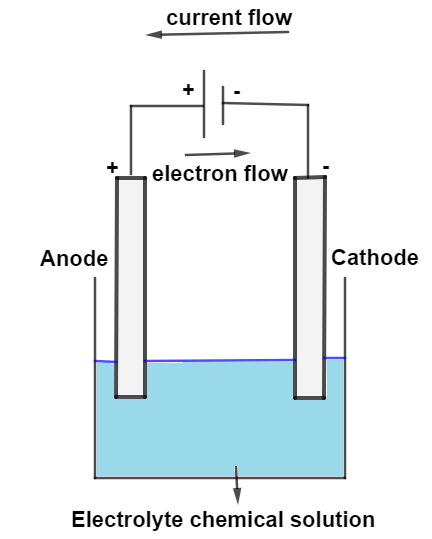
In an electrolytic cell current flows from?
A.Cathode to anode in outer circuit
B.Anode to cathode outside the cell
C.Cathode to anode inside the cell
D.Anode to cathode inside the cell.
Answer
485.1k+ views
Hint: An electrolytic cell is an electrochemical cell that uses electrical energy to drive a non-spontaneous redox reaction. It is often used to decompose chemical compounds, in a process called electrolysis and Electrons flow from anode to cathode.
Complete answer:
An electrolytic cell converts electrical energy into chemical energy. Here, the redox reaction is spontaneous and is responsible for the production of electrical energy. The reaction at the anode is oxidation and that at the cathode is reduction. The electrons are supplied by the species getting oxidized.

In an electrolytic cell, the negative terminal is the cathode/anode and is the site of the oxidation/reduction half reaction. In an electrolytic cell, the negative terminal is the cathode and is the site of the reduction half reaction. For an electrolytic cell however, this flow is not spontaneous but must be driven by an external power source. In an electrolytic cell, the anode has the "" sign. The potential difference between the electrodes causes electrons to flow from the reductant to the oxidant through the external circuit, generating an electric current.
So, the correct answer is (C) cathode to anode inside the cell.
Note:
Remember Current does not flow out of a battery. Current, a movement of electrons, flows from one part of the battery richer to the other part poorer of them. Batteries put out direct current, as opposed to alternating current, which is what comes out of a wall socket. With direct current, the charge flows only in one direction. With alternating current, the charges slosh back and forth, continually reversing direction.
Complete answer:
An electrolytic cell converts electrical energy into chemical energy. Here, the redox reaction is spontaneous and is responsible for the production of electrical energy. The reaction at the anode is oxidation and that at the cathode is reduction. The electrons are supplied by the species getting oxidized.

In an electrolytic cell, the negative terminal is the cathode/anode and is the site of the oxidation/reduction half reaction. In an electrolytic cell, the negative terminal is the cathode and is the site of the reduction half reaction. For an electrolytic cell however, this flow is not spontaneous but must be driven by an external power source. In an electrolytic cell, the anode has the "" sign. The potential difference between the electrodes causes electrons to flow from the reductant to the oxidant through the external circuit, generating an electric current.
So, the correct answer is (C) cathode to anode inside the cell.
Note:
Remember Current does not flow out of a battery. Current, a movement of electrons, flows from one part of the battery richer to the other part poorer of them. Batteries put out direct current, as opposed to alternating current, which is what comes out of a wall socket. With direct current, the charge flows only in one direction. With alternating current, the charges slosh back and forth, continually reversing direction.
Recently Updated Pages
Why are manures considered better than fertilizers class 11 biology CBSE

Find the coordinates of the midpoint of the line segment class 11 maths CBSE

Distinguish between static friction limiting friction class 11 physics CBSE

The Chairman of the constituent Assembly was A Jawaharlal class 11 social science CBSE

The first National Commission on Labour NCL submitted class 11 social science CBSE

Number of all subshell of n + l 7 is A 4 B 5 C 6 D class 11 chemistry CBSE

Trending doubts
1 Quintal is equal to a 110 kg b 10 kg c 100kg d 1000 class 11 physics CBSE

What is Environment class 11 chemistry CBSE

Bond order ofO2 O2+ O2 and O22 is in order A O2 langle class 11 chemistry CBSE

How many squares are there in a chess board A 1296 class 11 maths CBSE

Distinguish between verbal and nonverbal communica class 11 english CBSE

The equivalent weight of Mohrs salt FeSO4 NH42SO4 6H2O class 11 chemistry CBSE




